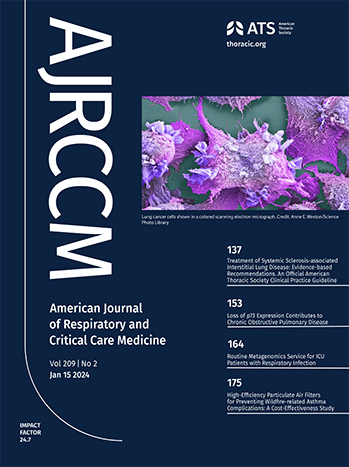Increased Driving Pressure During Assisted Ventilation for Hypoxemic Respiratory Failure Is Associated with Lower ICU Survival: The ICEBERG Study.
IF 19.3
1区 医学
Q1 CRITICAL CARE MEDICINE
American journal of respiratory and critical care medicine
Pub Date : 2025-06-20
DOI:10.1164/rccm.202411-2146oc
引用次数: 0
Abstract
RATIONALE Driving pressure is marker of severity and a possible target for lung protection during controlled ventilation, but its value during assisted ventilation is unknown. Inspiratory holds provide an estimate of driving pressure (quasi-static). Expiratory holds provide an estimate of the inspiratory effort, useful to estimate the transpulmonary dynamic driving pressure. OBJECTIVES To assess the correlation between driving pressures measured during assisted ventilation and ICU outcomes. METHODS Multicenter prospective observational study. Patients with acute hypoxemic respiratory failure were enrolled within 48 hours of triggering the ventilator. Respiratory mechanics were measured daily and the variables of interest averaged over the first three days of partial assistance. ICU outcomes were collected until day 90. MEASUREMENTS AND MAIN RESULTS Two-hundred ninety-eight patients from 16 centers were enrolled. Tidal volume, peak airway pressure, positive-end-expiratory-pressure and inspiratory effort during the first three days of assisted ventilation did not differ between survivors and non-survivors. Quasi-static driving pressure and transpulmonary dynamic driving pressure were higher in non-survivors than in survivors (13 [11,14] vs 11 [9,13] cmH2O, p<0.001 and 19 [16,23] vs 16 [13,18] cmH2O, p<0.001, respectively), while compliance normalized to predicted body weight was lower (0.65 [0.54,0.84] vs 0.79 [0.64,0.97] ml/cmH2O/kg, p<0.001). Multivariable analysis confirmed the association with outcome. Over study days, static driving pressure significantly diverged between survivors and non-survivors. CONCLUSIONS During assisted ventilation driving pressure and normalized compliance are associated with ICU outcome, despite some overlap. Albeit our study does not allow to estimate if driving pressure is a marker of severity, or a cause of lung injury, it highlights the potential value of monitoring and targeting it during spontaneous assisted breathing.低氧性呼吸衰竭患者辅助通气时驱动压升高与ICU生存率降低相关:ICEBERG研究
rationaldriving pressure是病情严重程度的标志,也是控制通气期间肺保护的可能目标,但其在辅助通气期间的值尚不清楚。吸气式保持提供驾驶压力的估计(准静态)。呼气保持提供了吸气力的估计,有助于估计跨肺动态驱动压力。目的评估辅助通气期间测量的驱动压力与ICU预后的相关性。方法采用多中心前瞻性观察研究。急性低氧性呼吸衰竭患者在触发呼吸机后48小时内入组。每天测量呼吸力学,在部分辅助治疗的前三天测量感兴趣的变量的平均值。收集ICU结果至第90天。测量方法和主要结果来自16个中心的298名患者入组。在辅助通气的前三天,幸存者和非幸存者之间的潮气量、气道峰值压力、呼气末正压和吸气力没有差异。非幸存者的准静态驱动压和跨肺动态驱动压高于幸存者(13 [11,14]vs 11 [9,13] cmH2O, p<0.001, 19 [16,23] vs 16 [13,18] cmH2O, p<0.001),而对预测体重的依从性标准化较低(0.65 [0.54,0.84]vs 0.79 [0.64,0.97] ml/cmH2O/kg, p<0.001)。多变量分析证实了与结果的关联。在研究期间,幸存者和非幸存者之间的静态驾驶压力明显不同。结论在辅助通气期间,驱动压力和标准化依从性与ICU预后相关,尽管有一些重叠。虽然我们的研究不能估计驾驶压力是严重程度的标志,还是肺损伤的原因,但它强调了在自主辅助呼吸期间监测和瞄准它的潜在价值。
本文章由计算机程序翻译,如有差异,请以英文原文为准。
求助全文
约1分钟内获得全文
求助全文
来源期刊
CiteScore
27.30
自引率
4.50%
发文量
1313
审稿时长
3-6 weeks
期刊介绍:
The American Journal of Respiratory and Critical Care Medicine focuses on human biology and disease, as well as animal studies that contribute to the understanding of pathophysiology and treatment of diseases that affect the respiratory system and critically ill patients. Papers that are solely or predominantly based in cell and molecular biology are published in the companion journal, the American Journal of Respiratory Cell and Molecular Biology. The Journal also seeks to publish clinical trials and outstanding review articles on areas of interest in several forms. The State-of-the-Art review is a treatise usually covering a broad field that brings bench research to the bedside. Shorter reviews are published as Critical Care Perspectives or Pulmonary Perspectives. These are generally focused on a more limited area and advance a concerted opinion about care for a specific process. Concise Clinical Reviews provide an evidence-based synthesis of the literature pertaining to topics of fundamental importance to the practice of pulmonary, critical care, and sleep medicine. Images providing advances or unusual contributions to the field are published as Images in Pulmonary, Critical Care, Sleep Medicine and the Sciences.
A recent trend and future direction of the Journal has been to include debates of a topical nature on issues of importance in pulmonary and critical care medicine and to the membership of the American Thoracic Society. Other recent changes have included encompassing works from the field of critical care medicine and the extension of the editorial governing of journal policy to colleagues outside of the United States of America. The focus and direction of the Journal is to establish an international forum for state-of-the-art respiratory and critical care medicine.

 求助内容:
求助内容: 应助结果提醒方式:
应助结果提醒方式:


